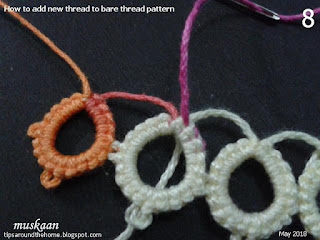The task was
split chains and floating chains. I chose floating chains -
also known as dead end chain, curlicue, or single shuttle split chain (SSSCh).
This black butterfly with curlicue antennae and the 3 with venetian picots (a variation of
floating chains) was my earlier submission for the task. However I have a
feeling that it was not appreciated by the ladies there. In any case I needed
to complete the card topper.
I
had gifted the earlier card to my SIL. MIL liked it very much, so this
butterfly edging card is for her. For the card topper I used handmade paper
with herbs embedded in it. I glued some folded paper underneath to raise the level
slightly.
Rummaging
through my many little scrap pieces, I tried to choose and arrange them into some
collage (taking many pics to remember the arrangements) but finally settled on
a fairly simple arrangement. I absolutely loved how Jane's Maltese Sunflower
looked here, so that stayed obviously. And these were the only 3 butterflies
that seemed proportionate.
Time to work on the foliage.... A helper thread worked wonders to wrap around the hand and hold the core thread taut while encapsulating.
I mentioned this in my tutorial especially for fine thread, but didn't show it on the fingers.
All chains are spiral or Josephine chains. I like the texture and dimension they create without taking up too much space. In Anchor size 40, they are about 4cms tall maximum.
While
working on the foliage my Lizbeth specialty packs (size 20) arrived and I
made one more butterfly using floating chain tipped with a Josephine ring
for each antenna.
Unfortunately it was too large for this scenery at 2-2/5×2 cms (2½cms high with antennae).
The tatting SOUP has been arranged then glued!
I deliberately followed the slant of the herbs in the handmade paper - it is what inspired this nature collage. But it still needs some balance and sparkle.
3 Swarovski crystals glued inside corner
florets.
Unfortunately, my stash was lacking in anything smaller for the rest of the florets.
Added
another little foliage on top of flower.
And to echo the crystals, I tatted and glued a
Josephine chain cord using metallic embroidery thread all around the topper.
The core is size 40
crochet cotton for easier handling.
TIP: When making long
JChs, I like to wind the chain thread on a shuttle too.
It is convenient to
dangle the shuttles and maintain the twist within both threads.
There
seems to be something missing along the outermost edge or periphery - too plain.
Any
ideas to bring it all together? Another silver chain all around?
Or 3
crystals in each corner? A mirror in each corner?
 |
| Check out what the others have made here. |
With the exception of the sunflower, the entire
card topper collage is worked with one shuttle and ball. A 2nd shuttle
was used only in case of 2nd colour or for convenience. There is no dearth of techniques and effects that can be created with a shuttle - including the many variations of SSSCh or floating chain!
under appropriate headings.
hope you have a great day with
lots of creative tatting floating in !





















































